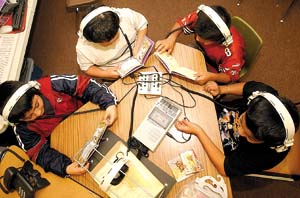
A small rural school on the outskirts of town is the site for an
innovative experiment in how children learn
– one which the program’s advocates believe is already showing
signs of success.
A small rural school on the outskirts of town is the site for an innovative experiment in how children learn – one which the program’s advocates believe is already showing signs of success.
Spring Grove School decided something different needed to be done for students who traditionally perform poorly in math and reading and don’t respond to traditional remediation, and they think they’ve finally hit on something.
“We’re working with the lowest performing students in school,” said Spring Grove teacher Lucia Bonnaud. “A lot of them had considered themselves failures, and had real low self-esteem issues. Here they find out that they can do it, that they can succeed.”
Spring Grove’s Math and Reading Academy, founded in the beginning of the fall semester in September, is targeted toward students who need extra attention in those two basic areas, and are recommended by their teachers to participate. Both students and parents sign an agreement committing the student to leave his regular class and join the academy, where he’ll receive intensive instruction in both subjects every day.
“Everyone learns a little differently,” said Howard Chase, Spring Grove principal and superintendent. “For these kids, maybe something didn’t click somewhere, and we designed this to give them more opportunities for success … The greatest gift you can give a child is the ability to read.”
Spring Grove currently has two Academy classes, one for fourth and fifth grade students and another for junior high-aged students. Though each teacher does things slightly differently, both classes spend about three hours a day focusing on reading, writing and spelling that they simply wouldn’t be able to do in a regular class, and about two hours of math.
“When I first heard about Mr. Chase’s idea, I begged him to be a part of it,” said Bonnaud, who teaches the younger class. “I used to be a resource specialist, and I always felt like I just needed more time with the kids. You would work with them for a few hours, and then see them go back to class and fail. It was discouraging.”
While the focus of the Academy program is reading and math, the teachers must weave other curriculum areas into their lessons to make sure students don’t miss out on material covered in the regular classrooms. For example, Bonnaud’s fourth and fifth graders are completing a writing assignment about Native Americans and another on colonial society to tie social studies into the student’s language arts skills.
“If they couldn’t read the social studies text in class, they had no chance of passing the tests,” Bonnaud said. “So we’re learning how to bring it all together in the classroom. But it’s still a new program, and I’m learning what I need as I go.”
After only four months, teachers say they’re already noticing fairly dramatic results. Bonnaud says roughly 90 percent of her students, who once were failing their classes, earn A’s and B’s on tests in both reading and math. It just takes a little extra time, she said.
“There’s no magic bullet for when these kids will be ready to move back into a regular class,” she said. “It’s not that easy, I wish it was. I feel in about two years my kids will be able to join with regular sixth graders, but I know they’ll at least walk into that class with more skills and a heck of a lot more self-esteem than when they started here.”
Not only are the Academy students benefiting academically, but educators say the program is helping students thrive socially, as well.
“You see these kids getting out and playing on the playground now,” Bonnaud said. “Before, these were the kids who would sort of wander off and keep to themselves … they have a little social network now, they can be themselves.”
So far, the Academy is the only program of its kind in San Benito County and Chase wasn’t aware of any such programs anywhere else. While the program’s success may partially be a result of the rural school’s small size – just under 550 students attend Spring Grove, and enrollment for each Academy class is capped at 20 – early results of the program could entice other local schools to explore the possibility of an Academy on their own campus.
“Personally, I’m a big proponent of this program,” said North County Board member Robert Bernosky. “I would encourage other school districts to visit our classrooms and ascertain for themselves what the results are… I believe this is something that could benefit the entire community.”
While no other school districts within the county have formally discussed setting up similar programs, the County Office of Education has done some classroom observation on the Academy, and educators from other districts are open to the idea.
“When parents, faculty and students all can buy into a solution about remediation, it’s a win-win situation,” said Jan Grist, president of the Hollister School District’s Teacher’s Union. “Whether it’s in school, after school or even on a Saturday, if you have parents, teachers and students all working together, you see student achievement soar.”
Danielle Smith covers education for the Free Lance. Reach her at 637-5566, ext. 336 or ds****@***********ws.com









